September 20, 2023
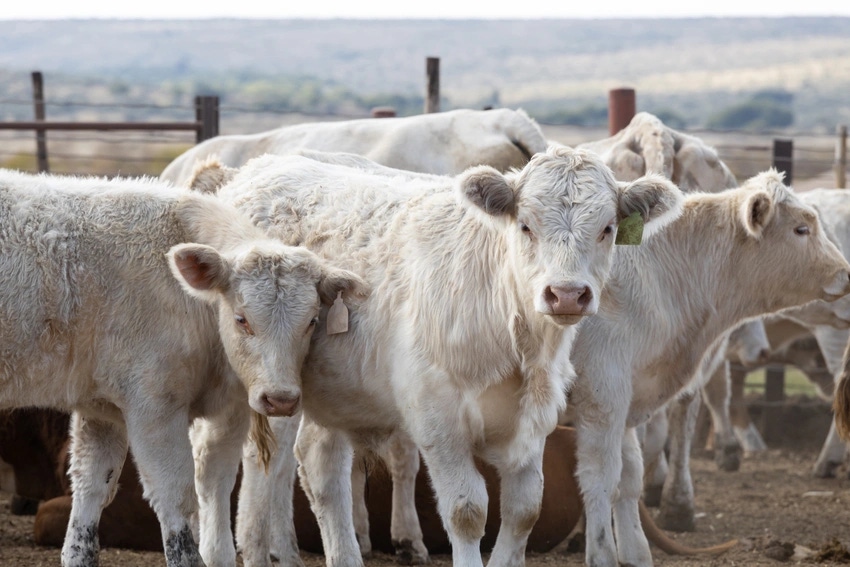
By Elliott Dennis, University of Nebraska- Lincoln
High Culling Continues to Occur
The annual fall feeder run is about to begin. Given cattle prices, forage conditions, and the economy the question of whether heifers will be retained to rebuild the beef cow herd remains uncertain. Consider these factors that give pause to whether this expansion will occur with as much momentum we might think.
Retail and Wholesale Ground Beef Prices
US consumers love eating ground beef. Ground beef is primarily made from beef trimmings. These trimmings can either come from the domestic or import market. In the domestic market, trimmings come from fed cattle (steers and heifers), bulls, and cows (dairy and beef). Fed cattle have more fat than bulls and cows so meat processors use trimmings from both to create different meat/fat blends such as the traditional 80/20 (i.e. 80% meat, 20% fat). Beef trimmings from the domestic market consist of about 70% of all beef trimmings used. The remaining 30% comes from imports.
The percentage of beef trimmings from steers and heifers is much more stable than cows/bulls since the latter tends to move lockstep with the cattle cycle. Imports and trimmings from bulls and cows tend to substitute for each other. As of recent, 75 percent of all beef imports are beef trimmings mainly coming from Australia and Brazil. However, this has dramatically dropped off in the last year to 65% and is almost entirely due to a reduced amount of beef trimmings being imported – down about 500 million pounds. This has in part led to higher prices for ground beef at retail. But consumers are still paying these higher prices.
Trying to determine what the upper ceiling consumers would pay for ground beef is hard to say. Comparing the Meat Demand Monitor (MDM) willingness-to-pay (WTP) vs. current retail ground beef prices indicates that ground beef prices could continue to rise another $2-3 at retail. Current retail prices for ground beef are about $5 per pound whereas the MDM WTP is estimated at approximately $8 per pound. It will likely not go that high as there is almost always a gap between what consumers say they will pay and what they actually pay. They will also substitute into other meat products lowering the quantity demand for ground beef. But the fresh 90% ground beef at wholesale will certainly push the retail ground beef price higher pulling more cows and bulls to be slaughtered (see Figure 1). Further, meat processing plants that have a ground beef line may be able to soften some of the impacts of higher fed cattle margins.

Boxed Beef Cutter Cow Cutout
There is a seasonal inversion in the boxed beef cutter cow price (see Figure 2). Seasonally prices normally climb till May/June and then decline through December as more cows come to town. In 2022, this seasonal trend was inverted as the market high came between January and April and then began to decline throughout the year. Contrast that with 2023, we followed the same seasonal pattern from January to May/June – gradually increasing albeit at nominally higher values. But rather than peaking and coming back down prices have continued on a steady upward trajectory reaching $243 per cwt. For perspective, this is what a 600-900 lb. Choice carcass was trading at in September 2023. Important to understand that this cutout value is calculated and consists of several subproducts each continuing at a fixed weight/proportion of the carcass. That allows us to determine what is driving that value higher. This higher price almost entirely contributed to strong prices for lean beef – approximately 85% to be exact. This is in line with the higher retail ground beef prices. Higher the cutout, the greater incentive to harvest more cows, thus limiting herd growth.
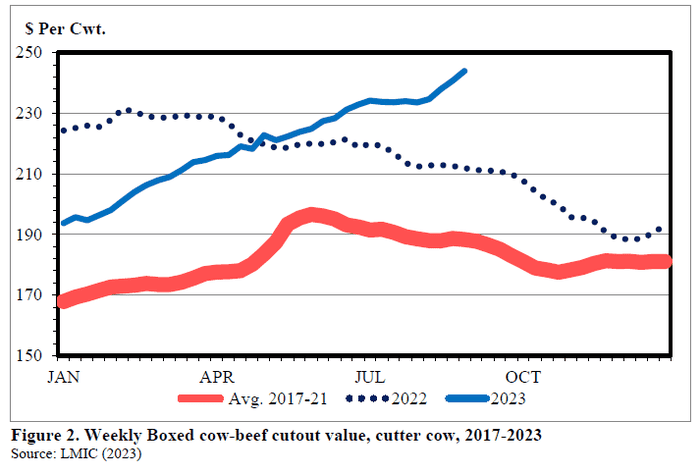
Cutter Cow and Slaughter Cow Prices
Cutter cow and slaughter cow prices have likewise remained high (see Figures 3-4). Both are significantly higher than both the 5-year average and 2022. National direct live cutter cow prices were trading at $94 per cwt. compared to $74 per cwt. a year ago and $54 per cwt. on average between 2017-2021. The seasonal pattern also shows that there is general price support at $90 per cwt. for cutter cows and $85 per cwt. Higher and stronger ground beef prices and boxed beef cutter cow cutout will only keep these prices high or increase them into the fall. These seasonally higher prices should continue to impact the beef cow slaughter rate.
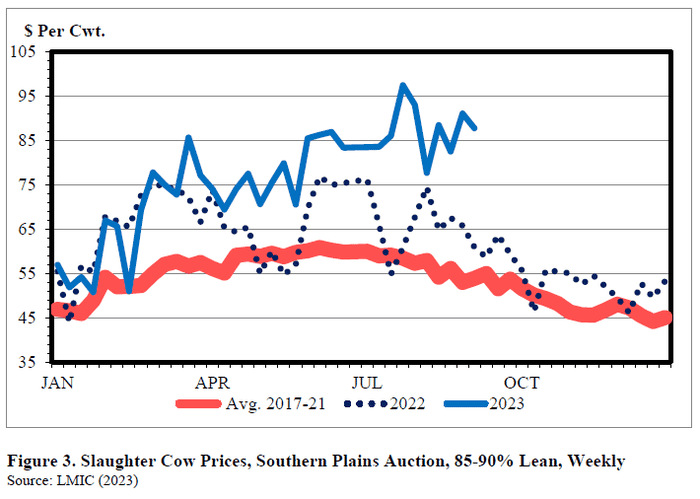
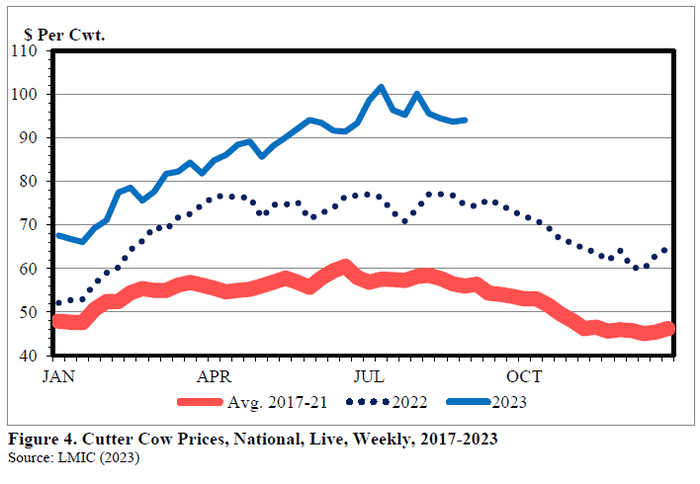
Beef Cow Slaughter
Beef slaughter continues to remain elevated above the 5-year average, on an annual basis, although the weekly slaughter rates have come more in-line during the last few months (see Figure 5). During periods of expansion, the typically seasonal uptick in cow slaughter in the fall is much smaller. Seasonally that uptick will not occur till the end of September. Watching the slaughter rate will provide some indication of what economic force is proving most powerful for producers. On one hand, we have the higher feeder cattle prices, current and deferred, which incentivizes the desire to retain cows and heifers to get profits in the future. However, there are also atypically seasonal incentives to sell both cull cows and heifers at higher current market values than previously experienced and forgo profits next year.
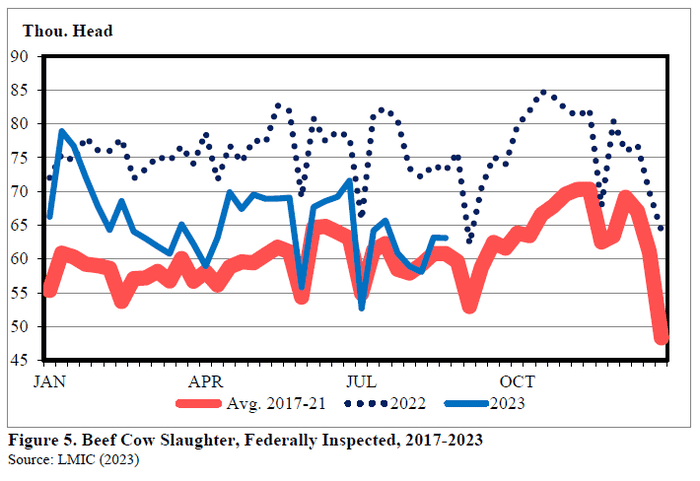
Heifers on Feed
Heifers as a percent of total cattle on feed continue to remain high – 40% – and remain at the highest levels they have been in the last 20 years (See Figure 6). The next USDA Cattle on Feed report will, in addition to feedlot inventories and marketings, indicate the number of heifers on feed. I anticipate this will still be high. The telling report will be the December report as that will indicate how many heifers were sent to feedlots during the entire fall run. With the current Choice-Select spread favoring more quality meat combined with cheaping feedstuffs (corn, distillers, forage) and higher feeder cattle prices, there are some reasons why feedlots may continue to feed current inventories longer rather than buying in more expensive feeder cattle. This could have an impact on the relative composition and fill of feedlots this fall delaying placements and putting downward pressure on feeder cattle prices.

Heifer Auction Receipts
Another indicator, although a much weaker one, is the total number of heifers being sold in auctions, direct, and video sales. Approximately 39% of all feeder cattle receipts were heifers. Separating out the natural seasonal movements can show the overall trend in the data. This shows that heifers as a percentage of all stocker cattle receipts has been slightly decreasing, albeit slowly, since the early part of this year (see Figure 7). Comparing this percentage to the last cattle cycle indicates that we are at the same percentage as we were in 2011. If the current trend continues we should see fewer heifers sold this fall. This should narrow the steer-heifer price spread up a bit.

Conclusion
In summary, as steaks, roasts, and other meats become more expensive, ground beef seems to be carrying the day. Lots of simple and easy-to-cook recipes while families attempt to stay within a budget all while general inflation, food included, continues to rise. Demand for lean beef is strong. Combine that with low imports of lean beef and cutter cow boxed beef prices are likely to remain high. This primary demand from consumers should continue to support higher prices for the slaughter cows. Ultimately, the tradeoff will be between chasing after those $310 per cwt. values on 500-600 lb. feeder cattle in 2024 and taking the cash up front this year. Producers need to be extremely diligent about calculating how much they can pay for replacement heifers as well as how much value that heifer has when she is retained rather than sold under current market conditions. Understanding what all needs to go right, and what can go wrong, for heifers and bred cows to pay themselves back will be extremely important this fall.
You May Also Like




